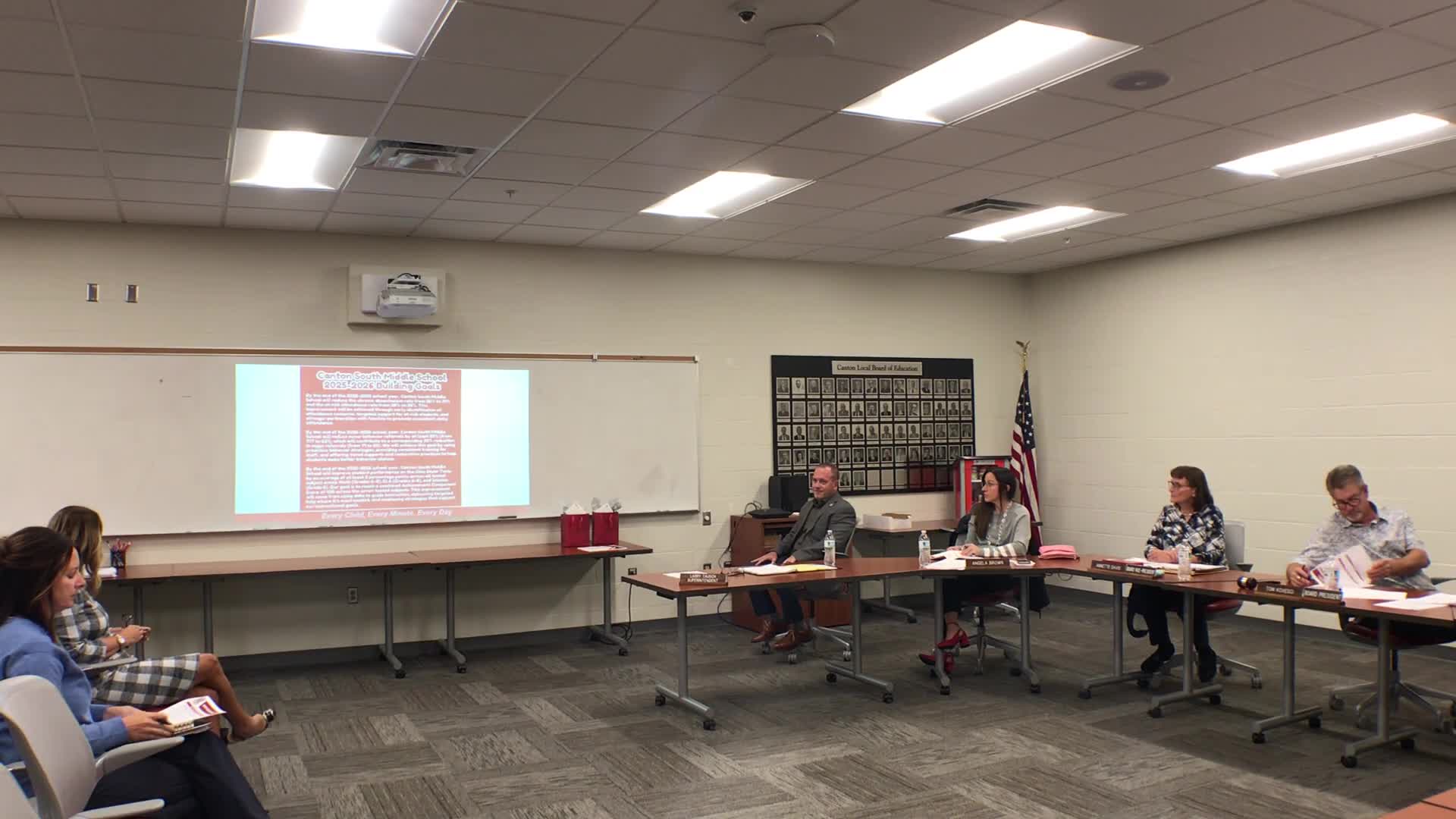Middle school sets measurable attendance, behavior and achievement targets; CareerTech posts strong outcomes
October 22, 2025 | Canton Local, School Districts, Ohio
This article was created by AI summarizing key points discussed. AI makes mistakes, so for full details and context, please refer to the video of the full meeting. Please report any errors so we can fix them. Report an error »

Middle-school and high-school leaders presented building-specific goals and results at the meeting.
Middle-school leadership said the school will focus on attendance, behavior and achievement. Adam Hall listed three measurable targets for the year: reduce chronic absenteeism from 26% to 21%; lower the at-risk rate from 38% to 35%; and improve each tested subject by approximately 3% to meet a district 4.25 combined achievement objective. Tactics include monthly attendance incentives, restorative practices to reintegrate students after disciplinary incidents, and extended intervention blocks (a 40-minute "red time") to provide targeted instruction.
Leaders described their behavior model: students accumulate minor referrals that escalate to major referrals after four incidents; the school is working to reduce minor referrals by 20% to decrease subsequent major referrals. Restorative conversations facilitated by administrators are intended to reduce repeat incidents.
High-school presenters noted an all-time high performance index (PI) score in some areas and a focus on graduation rate paperwork and reporting to convert work-based experiences into documented outcomes. School leaders also reported a student-center reward program and revised second-semester credit rules intended to keep students engaged and reduce credit loss.
Career and technical education (CTE) partners reported that South Star Career Academy and associated schools (Perry, Sandy Valley, East Canton and Kansas South) achieved a 5-star rating for CTE metrics. The presenter said the Perkins federal indicator was 88.9% (meeting 8 of 9 Perkins indicators) and highlighted credentials (OSHA 10, CPR), internships, 250+ hours of work-based learning for many students, and an upcoming showcase event for recruiting and outreach.
Administrators said several CTE outcomes are primarily paperwork and reporting improvements rather than changes to student experiences: they said ensuring OhioMeansJobs readiness seals and mentor sign-offs are filed for students with 250+ hours of work-based learning would increase readiness-seal reporting substantially without changing students' actual experiences.
No formal board actions or votes were taken on these presentations.
Middle-school leadership said the school will focus on attendance, behavior and achievement. Adam Hall listed three measurable targets for the year: reduce chronic absenteeism from 26% to 21%; lower the at-risk rate from 38% to 35%; and improve each tested subject by approximately 3% to meet a district 4.25 combined achievement objective. Tactics include monthly attendance incentives, restorative practices to reintegrate students after disciplinary incidents, and extended intervention blocks (a 40-minute "red time") to provide targeted instruction.
Leaders described their behavior model: students accumulate minor referrals that escalate to major referrals after four incidents; the school is working to reduce minor referrals by 20% to decrease subsequent major referrals. Restorative conversations facilitated by administrators are intended to reduce repeat incidents.
High-school presenters noted an all-time high performance index (PI) score in some areas and a focus on graduation rate paperwork and reporting to convert work-based experiences into documented outcomes. School leaders also reported a student-center reward program and revised second-semester credit rules intended to keep students engaged and reduce credit loss.
Career and technical education (CTE) partners reported that South Star Career Academy and associated schools (Perry, Sandy Valley, East Canton and Kansas South) achieved a 5-star rating for CTE metrics. The presenter said the Perkins federal indicator was 88.9% (meeting 8 of 9 Perkins indicators) and highlighted credentials (OSHA 10, CPR), internships, 250+ hours of work-based learning for many students, and an upcoming showcase event for recruiting and outreach.
Administrators said several CTE outcomes are primarily paperwork and reporting improvements rather than changes to student experiences: they said ensuring OhioMeansJobs readiness seals and mentor sign-offs are filed for students with 250+ hours of work-based learning would increase readiness-seal reporting substantially without changing students' actual experiences.
No formal board actions or votes were taken on these presentations.
View full meeting
This article is based on a recent meeting—watch the full video and explore the complete transcript for deeper insights into the discussion.
View full meeting
